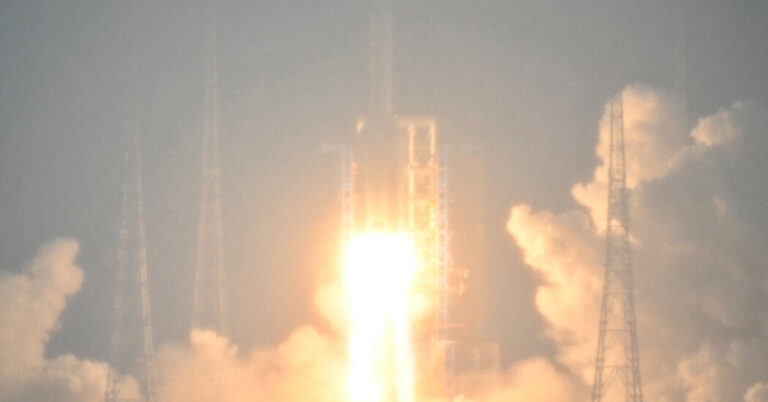China’s space agency announced Sunday morning that its lunar probe had successfully landed on the far side of the moon, bringing it one step closer to a mission to bring back the first samples from a part of the moon never seen by humans on Earth.
The China National Space Administration said in a statement that the unmanned probe Chang’e-6 landed in the moon’s South Pole-Aitken Basin at 6:23 a.m.
The agency released video taken by the probe’s landing camera as it touched down, showing the moon’s cratered surface getting closer and closer as the lander descends.
Chang’e-6, named after the Chinese moon goddess, is the second probe to land on the far side of the moon – its predecessor, Chang’e-4, made history in 2019 by becoming the first to do so.
The far side of the moon is different from the near side, where samples were taken by the US, China, and the then-Soviet Union. It has a thicker crust, more craters, and fewer maria, or plains where lava once flowed. It’s unclear why the two sides of the moon are so different, but the samples collected by Chang’e-6 may provide some clues.
The South Pole-Aitken Basin is a gigantic impact crater about 1,600 miles wide, one of the largest ever to occur in the solar system, and the impact that created it is thought to have excavated material from the Moon’s mantle that, if recovered, could help scientists learn more about the Moon’s interior history.
China is the only country to have ever sent a probe to the far side of the moon, and the probe is part of its growing space ambitions in an increasingly competitive global environment. China has successfully launched a Mars probe and plans to visit an asteroid in the future. It also aims to put humans on the moon by 2030, which would make it the second country to do so after the United States.
Chang’e-6 will be the third lunar landing mission this year. Japan became the fifth country to reach the moon’s surface when its lunar rover, Smart Lander, landed on the moon in January. Odysseus, a private spacecraft built by Houston-based Intuitive Machines, landed on the moon in February.
Chang’e-6 launched on May 3 from the Wenchang Space Station on China’s southern island of Hainan. It arrived at the moon on May 8 and orbited the moon for several weeks before landing, according to the China Space Agency. The descent took about 14 minutes, and the probe used cameras and 3D laser scanning to avoid obstacles as it landed, the agency said.
The space agency said the rover will spend around two days collecting samples, gathering rocks and soil from the lunar surface, as well as drilling into the ground to collect subsurface samples.
It will then spend a few more weeks in lunar orbit before preparing for a five-day return to Earth. The entire mission is expected to take about 53 days, according to NASA.
Missions to the far side of the Moon are complicated by the impossibility of establishing direct communication with a spacecraft there.
China launched the Magpie Bridge satellite into lunar orbit in 2018 to relay information from Chang’e 4 back to Earth, and a second satellite in March this year. The two satellites will work in tandem to maintain contact as Chang’e 6 collects samples.
Prince Xu Contributed report.

